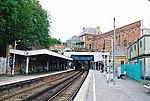Crystal Palace transmitting station
All accuracy disputesBuildings and structures in the London Borough of BromleyCrystal Palace, LondonEngvarB from September 2017History of television in the United Kingdom ... and 6 more
Infrastructure in LondonLattice towersMedia and communications in the London Borough of BromleyRadio in the United KingdomTelevision in the United KingdomTransmitter sites in England

The Crystal Palace transmitting station, officially known as Arqiva Crystal Palace, is a broadcasting and telecommunications site in the Crystal Palace area of the London Borough of Bromley, England (grid reference TQ339712). It is located on the site of the former television station and transmitter operated by John Logie Baird from 1933.The station is the eighth-tallest structure in London, and is best known as the main television transmitter for the London area. As such, it is the most important transmitter in the UK in terms of population covered. The transmitter is owned and operated by Arqiva.
Excerpt from the Wikipedia article Crystal Palace transmitting station (License: CC BY-SA 3.0, Authors, Images).Crystal Palace transmitting station
Crystal Palace Parade, London
Geographical coordinates (GPS) Address Nearby Places Show on map
Geographical coordinates (GPS)
| Latitude | Longitude |
|---|---|
| N 51.424167 ° | E -0.075 ° |
Address
Crystal Palace Parade
SE19 1UE London (London Borough of Bromley)
England, United Kingdom
Open on Google Maps











